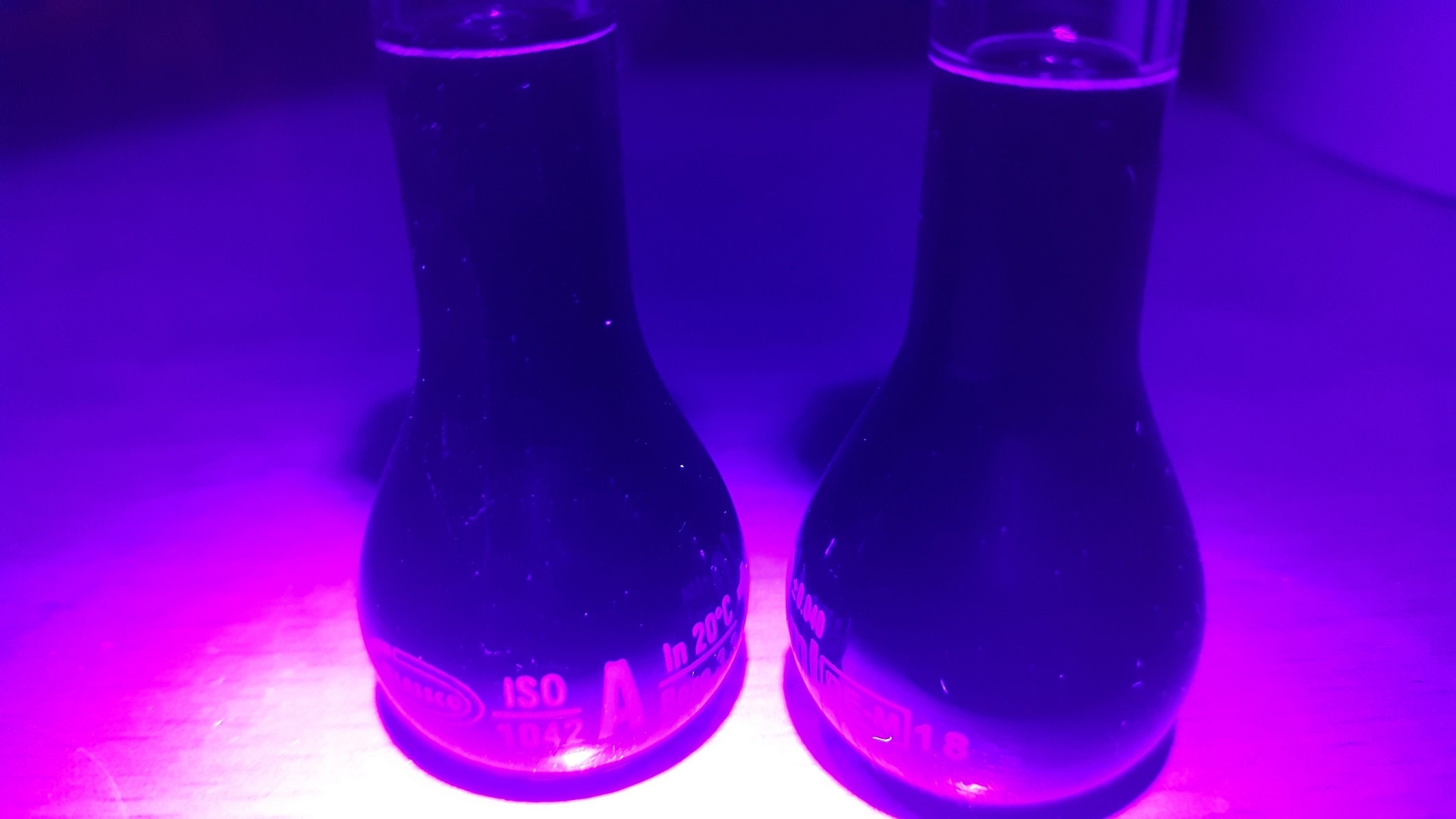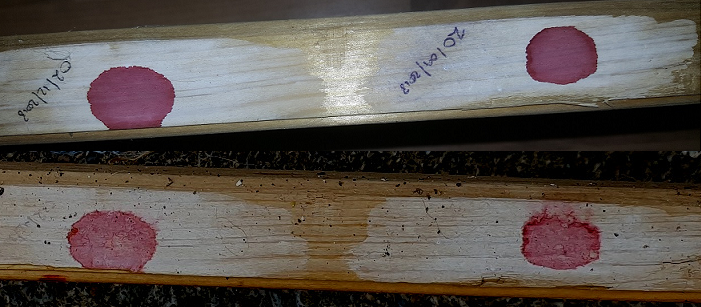The science behind the ink
Measurement of UV interaction and stability.
Light-fastness was previously established using a blue wool test on samples exposed to a 1kw mercury vapor lamp in multiple 30 minute intervals. However I have found a more robust way to test the inks is to apply them to a ceramic substrate and expose them to UV then use a surface spectrometer to compare changes. This rules out the limitations of the human eye and can reveal other changes to the inks chemistry on exposure to UV, such as haze.
Liquid ink samples are now tested against a solvent blank in a Thermo Evolution 201 spectrophotometer. 100ul of a given ink is dissolved into 10ml of UV-Vis spec solvent and a 1ml aliquot is placed into 5 cuvettes then exposed to UV. The quartz of the cuvette allows for maximum transmittance of UV light. After a certain time the 5 UV exposed samples are scanned then the remaining 5 unexposed samples are scanned and the spectra are over-layed and averaged. So 5 UV exposed samples are averaged against 5 non exposed samples. I have ran this same analysis against two other well known brands also with shocking results.
This type of analysis has two benefits; 1. Very small changes can be detected. 2. The bandwidth of light being absorbed by the sample can be precisely known from the UV to visible light spectrum.
The picture below shows two prepared samples under intense focused UV. This is performed in a specially designed enclosure because the intensity of UV radiation is very dangerous to skin and eyes, and requires artificial cooling. The imagining device does not know how to interpret the UV light and as such looks a beautiful violet color and this is actually were the inspiration for Gancanagh came from ;)

More real life testing.....
I placed a sample of my Pluma (chosen because it contains blue and red) onto a piece of wood treated with Kelpie, the first sample was placed 20/09/2018, the second was placed on 02/12/2018.
The sample was left outdoors exposed to the elements and south facing into the sun.
The image below shows the sample, the picture on the top was taken on 07/12/2018 (taken a week after the second sample of Pluma was applied which shows how little the ink changed from September to December) and the picture on the bottom was taken 29/05/2019. You can see how the Kelpie was affected by water which in turn had an interaction with the ink. This was actually power washed because I forgot to pick it up....
Another interesting point is the change in the biro ink from the top picture to the bottom, the biro ink has all but faded completely in the bottom (most recent) picture.

Toxicity
I am always surprised by the number of people that do not understand what toxicity really is and how routes of exposure are so important. Also the environment you are exposed to substances in can actually affect their toxicity! For example, Oxygen which we all know and love is actually toxic above 1 atmosphere of pressure. Caffeine is another example of a well known substance which can be come toxic at high levels.
Most brands of organic solvent based inks use alcohol... more specifically Ethanol. Due to the price of pure Ethanol being so high (due mostly to alcohol taxation) manufactures use denatured Ethanol. However, I seldom see any mention of the denaturation solvent used! Its in there, because I see it when I put samples into my GCMS (instrument that separates substances into its components then burning them in ultra clean hydrogen and scanning the combustion products) but its not on the label.... These denaturants are added to make the Ethanol toxic to drink, hence the inks being toxic. In addition to that however, the color agents can be themselves toxic. They are toxic through skin contact, respiration and yeah, obviously by drinking them.
When Kielty ink was first formulated it was done with a secondary alcohol and a ketone. 2-Propanol (isopropyl alcohol) and 2-Propanone (acetone) to be more precise. I elected to not use ethanol as pharmaceutical ethanol is so expensive it made it impractical and I refused to use denatured ethanol (or industrial methylated spirits also known as IMS) due to its toxicity. Apart from this I know some artists with addiction issues and they found that the smell of ink was making them almost fall off the wagon.... or onto it depending on your/their perspective!
A few reformulations later I have now completely removed alcohol from my ink, it uses exclusively acetone as its solvent. Why acetone though? Well simple, our biology can actually metabolize ketones directly into forms of energy and other natural substances which are easily eliminated. Kielty Ink would only be deemed mildly toxic if ingested and would take quite a few bottles to build up to toxic levels in the body, what happens in this event is that a high level of ketones causes the pH of your blood to spike, which can be fatal. To help put this into perspective the LD50 (or dose required to cause 50% fatality in a test group) for a black rat is about 5800 mg/kg (the average mass for a black rat is about 250g) this means that to kill 50% of a black rat test group each rat would need to ingest 1,450 mg of acetone, so in the context of a human that weighs 70 kg that means they would need to ingest about 406 g of acetone to reach a 50% potential lethal dose. There are medical case studies of people that have ingested ~800 g of pure acetone and rendered unconscious, through medical intervention they recovered without and serious lasting effects. If you were to contrast that to Ethanol, if that same person drank 800 g of pure Ethanol they would be pushing up daisies and even with medical intervention there would be probably CNS / optic nerve damage.
Acetone is actually produced in your body normally, and in even higher amounts when fasting or dieting due to fat catabolism.
So in regards to toxicity of my ink..... if you drink about thirty 15ml bottles you MIGHT be in trouble. If you drink thirty bottles of my ink your not using it right! Just don't fart near a candle and you should be okay.
On a more serious note, if someone does manage to drink my ink.... eh just go to a doctor and ask for: 1. A checkup, 2. A dunce cap, 3. An industrial strength toothbrush and finally 4. Yupo. C'mon, that was funny -.-
Oh and bring the bottle to show the label so the medical staff can have a good giggle after you leave :)
So under normal use your routes of exposure are dermal and respiratory and as such you will never reach the LD50 unless you take swim in it or squeeze your head n' hands into a shoebox along with some inks and spend a few hours arting away.
